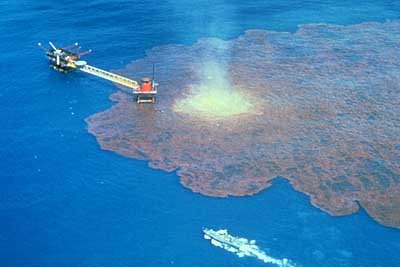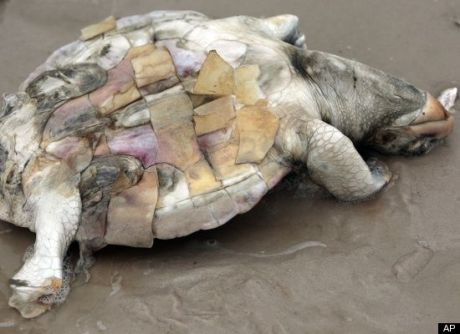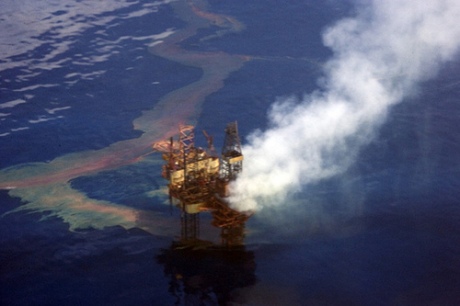Oil Execs Testify Before Congress…Technically May 11, 2010
Posted by Jamie Friedland in Offshore Drilling, Politics.Tags: 2010 Oil Spill, BP, cantwell, Congress, Deepwater Horizon, EPA, Gulf of Mexico, Halliburton, ixtoc, landrieu, menendez, Montara, murkowski, Offshore Drilling, Oil, Oil Spill, Senate, sessions, testimony, Transocean
3 comments
In case you didn’t have the pleasure of watching executives from BP, Halliburton and Transocean testify before Congress Tuesday afternoon, I have compiled some highlights and thoughts below.
The testimony in the U.S. Senate Committee on Energy & Natural Resources was revealing in how little it revealed. If we are to learn from and respond to this tragic event, people will have to start changing their tunes. As of today, they have not. I mean that in respect to both the oil executives and many of our U.S. senators. We’ll do the Big Oil execs first, then get into the senators.
First, the Big Oil execs:
If you have watched this kind of congressional testimony before, you know it is the world’s most boring dance. Senators ask questions, and those testifying carefully choose their words to convey as little as possible – or claim memory loss. Sometimes a senator will pursue an answer, but rarely does that actually extract the desired truth.
The only questions Big Oil actually answered today were those that Google could just have easily have answered, such as “is your company the largest offshore drilling contractor?”
Corporate legal teams carefully prep their executives to legally dodge the most damning questions. That preparation, which largely defeats the purpose of these hearings, was on notable display twice this afternoon.
For over a week now, BP has said it is prepared to pay “all legitimate claims.” They’ve been talking a big game about how they plan to repay their victims.
Conveniently, BP has yet to define exactly what claims it considers “legitimate.” They are unlikely to do so until they are taken to court. In his testimony, when pressed on this question, BP America President Lamar McKay did nothing but repeat that deliberately ambiguous phrase.
When general prodding from several senators went unanswered, Sen. Maria Cantwell (D-WA) finally tried to hold BP accountable. She went down a list of likely claims against BP. McKay’s response was the same nearly every time: “all legitimate claims.”
“1) Shrimpers who can’t earn their livelihoods?”
“We will pay all legitimate claims.”
“2) Beaches spoiled, tourism ruined?”
“All legitimate claims.”
“3) Children sickened by oil fumes?”
“All legitimate claims.”
Ad nauseam.
To top it off, McKay had the gall to follow up this laughable interaction with a preposterous assurance: “this is not about legal words, it’s about getting it done and getting it done right.” No, sir, this is PRECISELY about legal words. Please refrain from lying under oath, Mr. McKay. It’s frowned upon.
The second most odious exchange of the hearing was when Transocean President and CEO Steven Newman was asked if this type of spill had happened before. He replied that the only incident he could recall was the Ixtoc spill. To his credit, that spill was the worst of this type, but this answer is incredibly deceitful.
You’re trying to tell me that that Steven Newman, presumably a lifelong oilman, the president and CEO of an offshore drilling company that specializes in deepwater drilling, has to go back 31 years to recall an incident like this one? I’ve never worked in the oil industry and even I know that THIS TYPE OF SPILL HAPPENED 8 MONTHS AGO (Halliburton is suspected to have caused that one too)! In fact, even the photographers in that hearing room knew about the Montara spill: Sen. Menendez brought it up earlier in this very hearing!
Note that the response was deliberately and delicately phrased (“the only incident I can recall“) so as to avoid committing perjury.
Even as oil is gushing into the Gulf of Mexico, the oil industry and their congressional allies are STILL trying to cast offshore drilling as a safe practice. This spill was not unconceivable and not unprecedented. Senators and oil executives repeatedly called this accident “unique.” The only thing unique about this oil well was that it was in even deeper water and even deeper underground than usual, so all the real risks associated with drilling and the complications of containment and cleanup for spills were MAGNIFIED!
It is also worth mentioning the conduct of the senators present:
The oil executives weren’t the only ones choosing their words carefully. When I tuned in, Sen. Lisa Murkowski (R-AK) had the microphone. She was going to great lengths to avoid saying the words “oil” or “spill.” She even referred to the Exxon Valdez “incident.” This type of disingenuous wordplay is normally reserved for company spokespeople. Sadly, this is par for the Murky course.

Lisa Murkowski (R-AK): It is difficult (although sadly, not THAT difficult) to find a U.S. senator doing LESS for the American people and more for industry special interests.
Murkowski is often derisively labeled as (R-OIL) because of her industry ties. It is her “dirty air” amendment in the Senate that is attempting to strip the EPA of its authority (and indeed Supreme Court-issued mandate) to regulate carbon dioxide under the Clean Air Act. It came as little surprise when news broke early this year that the amendment had not been written by the senator’s staff but rather by oil industry lobbyists themselves. She was merely their mouthpiece. The things money can buy.
In her opening statement, Murkowski, the ranking minority member of the committee, explained why we need domestic oil drilling: “for the sake of our nation’s economy, for the sake of our national security, and this incident not withstanding, for the sake of our world’s environment.” The economic and national security impacts of domestic offshore drilling have long been shown to be literally negligible, but I am genuinely curious to hear how this congressional oil flack would spin drilling as anything short of toxic for “our world’s environment.” Too bad Murkowski wasn’t under oath too.
Sen. Jeff Sessions (R-AL) also took the opportunity to extol the virtues of domestic offshore drilling. I would tell you more about his questioning, but I really don’t think I could. When he had the microphone, I almost felt sorry for the industry executives; he never really put together a coherent sentence. The inflection in his voice was raised when he stopped talking, and he clearly expected them to respond, but I didn’t even understand what he expected of them. How fortunate, then, that the executives were coached not to give actual answers anyways.
Sen. Mary Landrieu (D-LA) was talking tough for her state. She is in a fierce primary against a much more liberal opponent, Lt. Gov. Bill Halter. But all her barking is election-year antics. No congressperson receives more money from the oil industry than Landrieu, and she continues to push the lie that offshore drilling is vital to our country – even as oil begins to wash up on Louisiana beaches. Her priority is making sure BP pays her voters quickly enough that she will be reelected to continue to act against our country’s best interests.
Sen. Robert Menendez (D-NJ) and Sen. Maria Cantwell (D-WA) were on point and champions. They asked piercing questions and did their best to take the executives to task and get actual answers. Yet there is only so much one can do within this broken system.
Having watched some testimony before, I know that these proceedings were not that unusual. To me, this is not a defense of what transpired today but rather more proof that business as usual must change if we to move forward as a country, both in the context of this tragedy and more broadly. Congress is an inertial body, but a catastrophe of this magnitude demands action.
Full list of oil spill questions and answers here.
Conceivable and Precedented May 4, 2010
Posted by Jamie Friedland in Offshore Drilling, Politics.Tags: 2010 Oil Spill, Bahia de Compeche, blowout, Blowout Preventer, BP, Deepwater Horizon, Exxon, Exxon Valdez, Gulf of Mexico, Halliburton, Montara, Oil, Oil Spill
7 comments
***For newcomers: I have created a page of questions and answers about offshore drilling and this oil spill here.***
BP did not build containment devices before the disaster because it “seemed inconceivable” that the blowout preventer would fail.
– BP spokesman Steve Rinehart
“The sort of occurrence that we’ve seen on the Deepwater Horizon is clearly unprecedented.”
– BP spokesman David Nicholas
These are lies. Both of them. And I can prove it:
Blowouts aren’t inconceivable, they are actually fairly common.
I have already explained in detail how blowout preventers (the last line of defense against catastrophes like this) are known and even quantifiably proven to be woefully inadequate last lines of defense against this sort of disaster. A U.S. government report found 117 blowout preventer failures in just a 2 year period! And the oil industry knew this; each data point on that report’s survey was an actual blowout on an oil company’s offshore rig!
It is true that not every blowout leads to a catastrophic oil spill like this. Yet it doesn’t take an imagination to plot out a disaster scenario when highly pressurized, obviously flammable fuels come hurtling out of the ground with explosive force towards an oil rig. And the second lie is even more damning.
This “sort of occurrence” (the euphemism of the day) is not at all unprecedented: a similar blowout, oil rig fire and massive oil spill occurred off the northern coast of Western Australia just 8 MONTHS AGO. I want to swear here so badly.
Before I get into the more recent spill, I have to say that there have been plenty of significant offshore blowouts and oil spills (list here). The worst in history started on June 3, 1979. An exploratory well in the Bahia de Campeche (600 miles south of Texas) experienced a blow out. The oil and gas ignited, lighting the platform and soon causing it to sink. Unfortunately, that platform fell on top of the wellhead, severely hindering efforts to activate the failed blowout preventer (I know what you’re thinking: “failed blowout preventer? Those are the last line of defense! They never fail!” If you don’t understand that sarcasm yet, please read this).
The blowout preventer was ultimately closed, but it had to actually be reopened to prevent its complete destruction when some valves began to rupture. Between 10,000 and 30,000 barrels of oil gushed from that well every day for nearly 10 months until they finally capped the well on March 23 of the next year. 3.5 million barrels (147 million gallons) of oil were released.

As BP well knows, the precedent for this type of spill is well established. This oil well gushed for nearly 10 months from 1979-1980.
There have been many more blowouts since then, but lets jump to the most recent: a blowout on the West Atlas rig in the East Timor Sea created a gusher on August 21 just last year. Shockingly enough, a fire sparked. The spill continued for 74 days through November while it took crews 4 attempts to drill a relief well like they are now trying to do in the Gulf.
The “Montara” oil spill, as it was called, released an estimated 9 million gallons (Exxon Valdez = ~12 million gallons) into one of the world’s most pristine oceanic areas, but went largely unreported because of its remoteness.
The East Timor Sea was home to some of the world’s most iconic and endangered species including 15 species of whales and dolphins, at least 30 species of sea birds, and five species of sea turtles (it’s been an especially bad year for them). Furthermore, 10,000 communities and 7,000 fishermen rely on the area for their survival. Residents of villages in the region report skin problems and diarrhea from eating contaminated seafood. Fish catches have been reduced by 80%.
The Montara spill and the current crisis have a lot in common. The rigs involved were 2- and 3-years old, state-of-the art and reportedly safe. In both cases, early flow-rates were obviously understated. Both occurred in areas of vital ecological and even economic importance.
Yet all indications suggest that the Gulf spill will be far, far worse. The West Atlas rig didn’t sink. The flow rate in the Gulf is already much higher. And the Montara spill occurred in only 600 feet of water. The Deepwater Horizon rig spill is under more than a mile of water, and the oil deposit is more than twice as deep underground.
Recall that is took Australian crews 4 tries to drill a relief well. In case it hasn’t been made clear, that process involves drilling down to depth and then a long distance horizontally towards the first, leaking well. The goal of this extensive drilling is to locate and bore into the original pipeline, which is less than a foot across (at least for the East Timor pipe). So in the Gulf, crews will have to drill through 18,000 ft of sea floor beneath more than 5,000 of water. Then they have to drill laterally to find the pipe and pierce it from miles away. There is a reason this project is expected to take literally months, with barrels and barrels of oil leaking the whole time.
The biggest similarity between the two, however, is that the causes may have been identical. I wrote yesterday about Halliburton’s involvement in the “cementing” process for the Deepwater Horizon rig, and how experts believe that cracks in a faulty cementing job could be responsible for the current disaster in the Gulf. Interestingly enough, although the inquiry into the East Timor spill is not complete, investigators have identical suspicions about the cause of that spill. And I bet you can guess who was working on the cementing for that rig too – Halliburton.
Halliburton is still looking into the Montara spill. If we get the Gulf spill plugged, I would imagine they’ll start looking into this as well (although they won’t have to bother – we surely will). As Charlie Cray put it, “It’s starting to look like the only thing Halliburton can cap tightly is its own mouth.”
To be fair, BP’s lies are consistent with their actions. While they actively fought safety regulations that might have prevented this disaster, internal documentation suggests that their surprise at this incident is genuine. Stultifying and much closer to the actual meaning of inconceivable, but genuine.
In their 2009 exploration plan and Environment Impact Statement (EIS) for this well, BP wrote that it was virtually impossible for a major oil spill to occur that would cause serious damage to beaches, fish and mammals. They write repeatedly that it is “unlikely that an accidental surface or subsurface oil spill would occur from the proposed activities.” You know, because oil spills are virtually unheard of.
Even if a spill did occur, “due to the distance to shore (48 miles) and the response capabilities that would be implemented, no significant adverse impacts are expected.” And that’s it. Having said that, they made no plans about how they would respond if there was an “inconceivable” oil spill. Because what are the chances, really?

"Don't worry about our back-up plan. We don't have one. The rig will be 50 mi offshore, what could go wrong?"
That such a ridiculous EIS was accepted is further proof (not that any was needed after last year’s sex and drugs story broke) that industry is way too close with government regulators. No reasonable, independent citizen of this country would approve a drilling application that, instead of having a worst-case scenario response plan, simply said “that’s really unlikely, and we don’t think it will happen.” Incredible.


